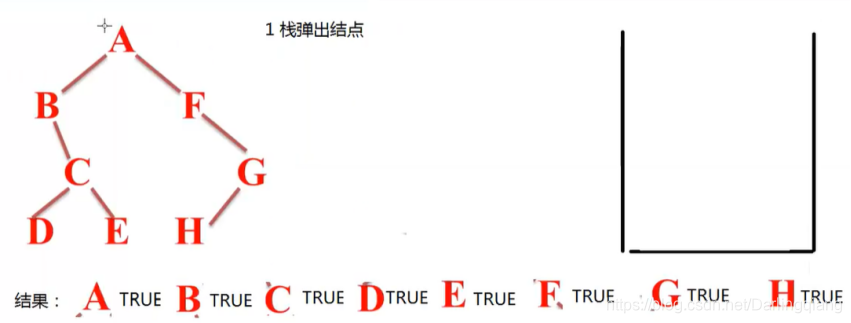非递归遍历实现思路:

#include <stdlib.h>
#include <stdio.h>
#include <iostream>
#include <string.h>
typedef struct LINKNODE {
struct LINKNODE* next;
}linknode;
typedef struct LINKLIST {
linknode head;
int size;
}stack_list;
#define MY_TRUE 1
#define MY_FALSE 0
typedef struct BinaryNode {
char ch;
struct BinaryNode* lchild;
struct BinaryNode* rchild;
}binarynode;
typedef struct BITREESTACKNODE {
linknode node;
BinaryNode* root;
int flag;
}bitreestacknode;
stack_list* Init_stack_list()
{
stack_list* stack = (stack_list*)malloc(sizeof(stack_list));
stack->head.next = NULL;
stack->size = 0;
return stack;
}
void Push_stack_list(stack_list* stack, linknode* data)
{
if (stack == NULL) {
return;
}
if (data == NULL) {
return;
}
data->next = stack->head.next;
stack->head.next = data;
stack->size++;
}
void Pop_stack_list(stack_list* stack)
{
if (stack == NULL) {
return;
}
if (stack->size == 0) {
return;
}
linknode* pnext = stack->head.next;
stack->head.next = pnext->next;
stack->size--;
}
linknode* Top_stack_list(stack_list* stack)
{
if (stack == NULL) {
return NULL;
}
if (stack->size == 0) {
return NULL;
}
return stack->head.next;
}
int Size_stack_list(stack_list* stack)
{
if (stack == NULL) {
return -1;
}
return stack->size;
}
void Clear_stack_list(stack_list* stack)
{
if (stack == NULL) {
return;
}
stack->head.next = NULL;
stack->size = 0;
}
void Free_stack_list(stack_list* stack)
{
if (stack == NULL) {
return;
}
free(stack);
}
//创建栈中的节点
BITREESTACKNODE* CreatBitreeStackNode(BinaryNode* node,int flag ) {
BITREESTACKNODE* newnode = (BITREESTACKNODE*)malloc(sizeof(BITREESTACKNODE));
newnode->root = node;
newnode->flag = flag;
return newnode;
}
//递归遍历
void Recursion(BinaryNode* root) {
if (root == NULL) {
return;
}
printf("%c", root->ch);
//打印左子树
Recursion(root->lchild);
//打印右子树
Recursion(root->rchild);
}
//非递归遍历
void NonRecursion(BinaryNode* root) {
stack_list* stack = Init_stack_list();
Push_stack_list(stack, (linknode*)CreatBitreeStackNode(root, MY_FALSE));
while (Size_stack_list(stack) > 0) {
//弹出栈顶元素
bitreestacknode* node = (bitreestacknode*)Top_stack_list(stack);
Pop_stack_list(stack);
//判断弹出节点是否为空
if (node->root == NULL) {
continue;
}
if (node->flag == MY_TRUE) {
printf("%c", node->root->ch);
}
else {
//当前节点的右节点入栈
Push_stack_list(stack, (LINKNODE*)CreatBitreeStackNode(node->root->rchild, MY_FALSE));
//当前节点的左节点入栈
Push_stack_list(stack, (LINKNODE*)CreatBitreeStackNode(node->root->lchild, MY_FALSE));
//当前节点的节点入栈
node->flag = MY_TRUE;
Push_stack_list(stack, (LINKNODE*)node);
}
}
}
void CreatBinaryTree() {
binarynode node1 = { 'A',NULL,NULL };
binarynode node2 = { 'B',NULL,NULL };
binarynode node3 = { 'C',NULL,NULL };
binarynode node4 = { 'D',NULL,NULL };
binarynode node5 = { 'E',NULL,NULL };
binarynode node6 = { 'F',NULL,NULL };
binarynode node7 = { 'G',NULL,NULL };
binarynode node8 = { 'H',NULL,NULL };
//建立节点关系
node1.lchild = &node2;
node1.rchild = &node6;
node2.rchild = &node3;
node3.lchild = &node4;
node3.rchild = &node5;
node6.rchild = &node7;
node7.lchild = &node8;
printf("Recursion traverse:
");
//递归遍历
Recursion(&node1);
printf("
");
printf("Non_Recursion traverse:
");
//非递归遍历
NonRecursion(&node1);
printf("
");
}
int main()
{
CreatBinaryTree();
system("pause");
return 0;
}


